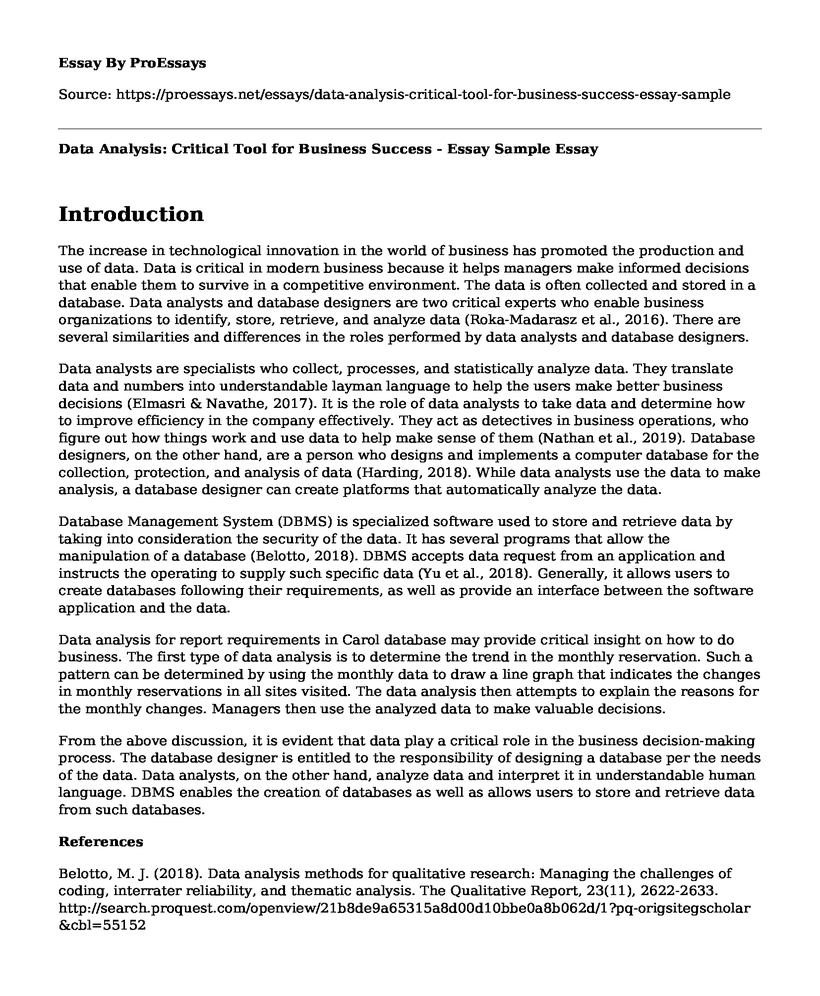Introduction
The increase in technological innovation in the world of business has promoted the production and use of data. Data is critical in modern business because it helps managers make informed decisions that enable them to survive in a competitive environment. The data is often collected and stored in a database. Data analysts and database designers are two critical experts who enable business organizations to identify, store, retrieve, and analyze data (Roka-Madarasz et al., 2016). There are several similarities and differences in the roles performed by data analysts and database designers.
Data analysts are specialists who collect, processes, and statistically analyze data. They translate data and numbers into understandable layman language to help the users make better business decisions (Elmasri & Navathe, 2017). It is the role of data analysts to take data and determine how to improve efficiency in the company effectively. They act as detectives in business operations, who figure out how things work and use data to help make sense of them (Nathan et al., 2019). Database designers, on the other hand, are a person who designs and implements a computer database for the collection, protection, and analysis of data (Harding, 2018). While data analysts use the data to make analysis, a database designer can create platforms that automatically analyze the data.
Database Management System (DBMS) is specialized software used to store and retrieve data by taking into consideration the security of the data. It has several programs that allow the manipulation of a database (Belotto, 2018). DBMS accepts data request from an application and instructs the operating to supply such specific data (Yu et al., 2018). Generally, it allows users to create databases following their requirements, as well as provide an interface between the software application and the data.
Data analysis for report requirements in Carol database may provide critical insight on how to do business. The first type of data analysis is to determine the trend in the monthly reservation. Such a pattern can be determined by using the monthly data to draw a line graph that indicates the changes in monthly reservations in all sites visited. The data analysis then attempts to explain the reasons for the monthly changes. Managers then use the analyzed data to make valuable decisions.
From the above discussion, it is evident that data play a critical role in the business decision-making process. The database designer is entitled to the responsibility of designing a database per the needs of the data. Data analysts, on the other hand, analyze data and interpret it in understandable human language. DBMS enables the creation of databases as well as allows users to store and retrieve data from such databases.
References
Belotto, M. J. (2018). Data analysis methods for qualitative research: Managing the challenges of coding, interrater reliability, and thematic analysis. The Qualitative Report, 23(11), 2622-2633. http://search.proquest.com/openview/21b8de9a65315a8d00d10bbe0a8b062d/1?pq-origsitegscholar&cbl=55152
Elmasri, R., & Navathe, S. (2017). Fundamentals of database systems (Vol. 7). Pearson.
Harding, J. (2018). Qualitative data analysis: From start to finish. SAGE Publications Limited.
Nathan, S., Govindarajan, C., Saraf, A., Sethi, M., & Jayachandran, P. (2019). Blockchain meets database: design and implementation of a blockchain relational database. Proceedings ofthe VLDB Endowment, 12(11), 1539-1552. https://dl.acm.org/citation.cfm?id=3360362
Roka-Madarasz, L., Malyusz, L., & Tuczai, P. (2016). Benchmarking facilities operation andmaintenance management using CAFM database: Data analysis and new results. Journal of Building Engineering, 6, 184-195. https://www.sciencedirect.com/science/article/pii/S2352710216300328
Yu, X., Xia, Y., Pavlo, A., Sanchez, D., Rudolph, L., & Devadas, S. (2018). Sundial: Harmonizing concurrency control and caching in a distributed OLTP database management system. Proceedings of the VLDB Endowment, 11(10), 1289-1302. https://dl.acm.org/citation.cfm?id=3242945
Zhang, B., Van Aken, D., Wang, J., Dai, T., Jiang, S., & Gordon, G. J. (2018). A demonstration of the other tune automatic database management system tuning service. Proceedings ofthe VLDB Endowment, 11(12), 1910-1913. https://dl.acm.org/citation.cfm?id=3275559
Cite this page
Data Analysis: Critical Tool for Business Success - Essay Sample. (2023, Apr 24). Retrieved from https://proessays.net/essays/data-analysis-critical-tool-for-business-success-essay-sample
If you are the original author of this essay and no longer wish to have it published on the ProEssays website, please click below to request its removal:
- Research Paper on Web Technologies
- Classification Essay Sample on Area Networks
- Windows Server Networking Paper Example
- Essay Sample on Business Outline
- The Internet & E-Commerce: A Global Connection - Research Paper
- Essay Example on Health Informatics Systems: Enhancing Acquisition, Storage, & Retrieval of Data
- Essay on Working Remotely: The Future of Job Market in the Digital Ag







